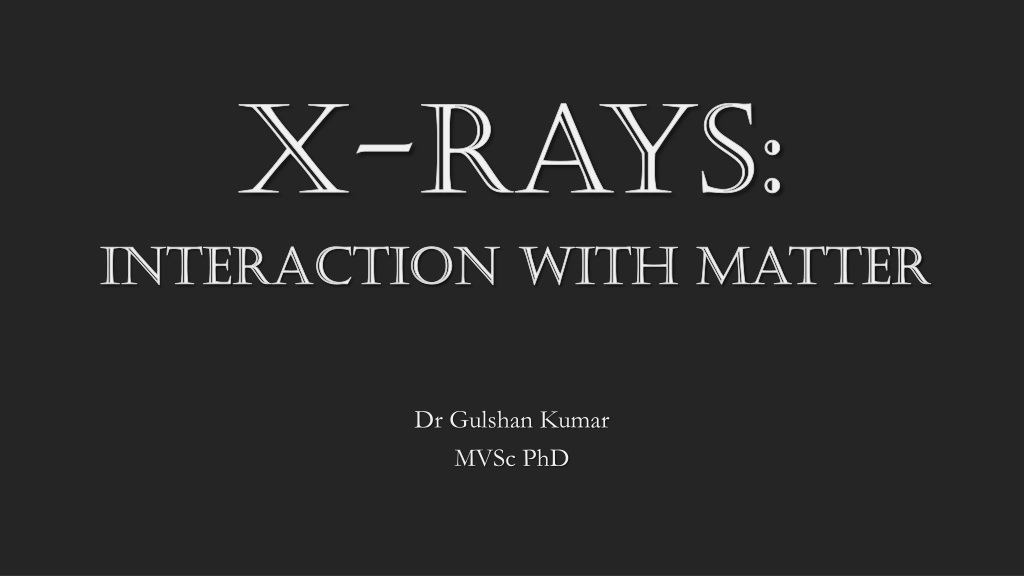

0 likes | 17 Views
X-rays, photons traveling at the speed of light, interact with matter in various ways when they impinge on it. These interactions include coherent scatter, Compton scatter, photoelectric effect/absorption, pair production, and photodisintegration. Each interaction process has distinct characteristics and implications, impacting image quality and radiation absorption in diagnostic procedures. X-ray photon interactions with atoms and electrons result in scattering, ionization, and even the production of characteristic x-rays. Understanding these processes is crucial for optimizing imaging techniques and radiation safety.

E N D
Dr Gulshan Kumar MVSc PhD
• X-rays are actually photons travelling with the speed of light. • Interaction.. How a photon interacts with matter on which it falls/impinges. • Matter may be tissue/cells/or non-biological material (here, we are considered with biological material only). • When the photon falls/strikes/impinges on the matter it encounters the atoms of that matter. • An atom comprises of a nucleus containing neutrons and protons around which are several orbits in which electrons are arranged (2n²)
• When x-ray photons enter the matter, they may: • Penetrate the matter, • Get absorbed in the matter, or • May get deviated and attenuated. • So………
• X-rays photons may interact with matter in five (05) ways: • Coherent Scatter • Compton Scatter • Photoelectric effect/absorption • Pair production • Photodisintegration
• Coherent Scatter (photon energy<10 kev) • The photon excites the whole of the atom • There is no ionisation • Electrons just vibrate in their orbits • The atom returns to relax and the photon leaves the atom slightly deflected from its original direction • Means it is scattered in different direction • Wavelength of incident and scattered photon are same • So no change in energy levels of photon • Aka Classical scatter , very small %age, only contribute a little to image noise.
• Compton Scatter (photon energy through out the diagnostic energy range i.e. 104to 10 5.5kev)) • The photon removes an outer shell electron. • Ionisation occurs. Some energy imparted to electron • Called Compton Electrons • The photon itself is deflected with increased λ and decreased energy • Only contribute to fog on image, and absorbed dose of patient and attendant/technician… independent of atomic no. (Z) • Liberate electron and scattered photon may cause further ionisations……… • Scatter can be in any direction….if backward….. “Back Scatter”
• Photo-electric effect/absorption (also with photon energy through out the diagnostic energy range i.e. 104to 10 5.5kev)) • The photon removes an inner shell electron. • Ionisation occurs. All energy imparted to electron the photo electron. • Photon gets absorbed, the ejected electron may act to form characteristic x rays of low energy from adjacent atoms… and so on. • Higher the Z, greater the absorption • Contribute to image formation • Increasing the photon energy decreases the probability of Photo- electric absorption. Even bone will be penetrated (darker).
• Pair production (with photon energy > 1.02 mega ev) • If the photon has higher energies then it will bye pass the electrons and interact with the nuclear field. • The photon disappears and a pair of electron and positron appears. • Does not occur in the diagnostic range of x rays.
• Photo-disintegration (with photon energy > 10 mega ev) • If the photon has higher energies then it will bye pass the electrons and interact with the nuclear field. • The photon disappears and nucleus disintegrates to nucleons. • Does not occur in the diagnostic range of x rays.